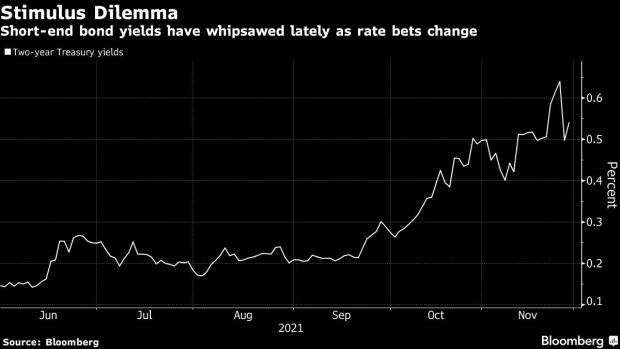Nov 29, 2021
Wall Street Dip Buyers Defy Omicron Inflation Risk at Their Own Peril
, Bloomberg News

(Bloomberg) -- If there’s any lesson for Wall Street in the pandemic era, it’s this: Every selloff has proved a big opportunity to buy the dip in a world of activist central banks and limitless risk appetite.
Yet the Monday rally as the omicron variant spreads will test the resolve of investors who thought they’d seen it all in the Covid roller coaster.
With fresh travel bans looming and transmission fears rife, S&P 500 futures rallied back after the index’s worst drop in nine months Friday. Treasuries slumped, sending yields higher, while oil jumped.
To the likes of Goldman Sachs Group Inc. and UBS Wealth Management, it all makes sense -- they reckon bad virus news has some good news for markets as the variant assuages fears of monetary tightening. But strategists at Capital Economics and Mizuho International are among those urging caution as rising cases may worsen inflation, keeping policy makers on track to cut stimulus.
The takeaway: the new variant has arrived at a drastically different point in the monetary cycle.
“I know, I know, ‘U.S. equities only go up’ etc,” wrote Peter Chatwell, head of multi-asset strategy at Mizuho. “Monetary tightening is a structural downside risk to equities, and it may coincide with weaker growth in Q1.”
While mild omicron symptoms and news of rapid vaccine reformulations are offering some relief Monday, European policy makers were already tightening rules to fight another wave of infections even before the mutation was discovered in southern Africa late last week.
The sharp risk-off session Friday, exacerbated by thin liquidity after the Thanksgiving holiday, was a sign of investors’ sensitivity to any bad headlines, with their pockets already thickly lined from the S&P 500’s 22% gain this year.
While corporations have managed to deliver a sharp profit recovery in 2021, stock valuations are elevated historically: The U.S. benchmark is trading at nearly 21 times the next year’s earnings, compared with 18 at the end of 2019 and a decade average of close to 17.
Whether that multiple counts as stretched will largely depend on the monetary trajectory. And since omicron hit the headlines, money-market traders have pushed back expectations for global rate hikes, market-derived inflation expectations have fallen and oil has plunged.
All that is a sign markets are pricing in a drop in demand from the new variant, which may prompt central banks to slow their tightening.
“Ironically, it may be the omicron scare itself that now creates the best possibility of some relief over the period, either because incoming news about the variant is better than feared or because monetary policy makers take a somewhat more cautious stance in response to the news,” wrote Dominic Wilson at Goldman.
At UBS’s wealth-management unit, a team led by chief investment officer Mark Haefele is telling clients to stay invested with the base case of robust economic growth intact and any concerns only likely to reduce monetary-tightening fears. At Nordea Investment Funds, senior macro strategist Sebastien Galy calls it a buying opportunity.
After a spike in volatility like the VIX’s 10-point jump Friday, stocks usually stage “robust reversals,” writes Jonathan Golub, chief U.S. equity strategist at Credit Suisse, in a Monday note.
Yet the policy response function may be less clear-cut than it was in the first all-hands-on-deck phase of the pandemic. Last year’s experience underscored the risk that if consumers shift their spending toward goods amid supply-chain bottlenecks, renewed virus anxieties can actually be inflationary.
New infections may also temporarily shrink the labor force, suggests Neil Shearing, chief economist at Capital Economics.
“Compared to previous waves of the virus, which were on balance disinflationary, a major new wave could now be inflationary,” he wrote in a note. “All of this further complicates an already-complex policy challenge.”
It’s a big shift from a week ago, when investors were largely preoccupied with the rate outlook based on the pace of the U.S. recovery. An index for economic surprises only this month returned to positive territory, as payrolls and retail sales expanded faster than expected.
But for investors giddy after the 66 record highs notched by the S&P 500 this year, an intensifying Covid risk is hard to ignore.
“I am not too positive on the situation as the cause of the selloff was the new variant, but it is also worth considering that the number of infections levels in Europe were unfortunately increasing anyway,” said Alberto Tocchio, a portfolio manager at Kairos Partners. “We will need more data before we will be able to judge.”
©2021 Bloomberg L.P.